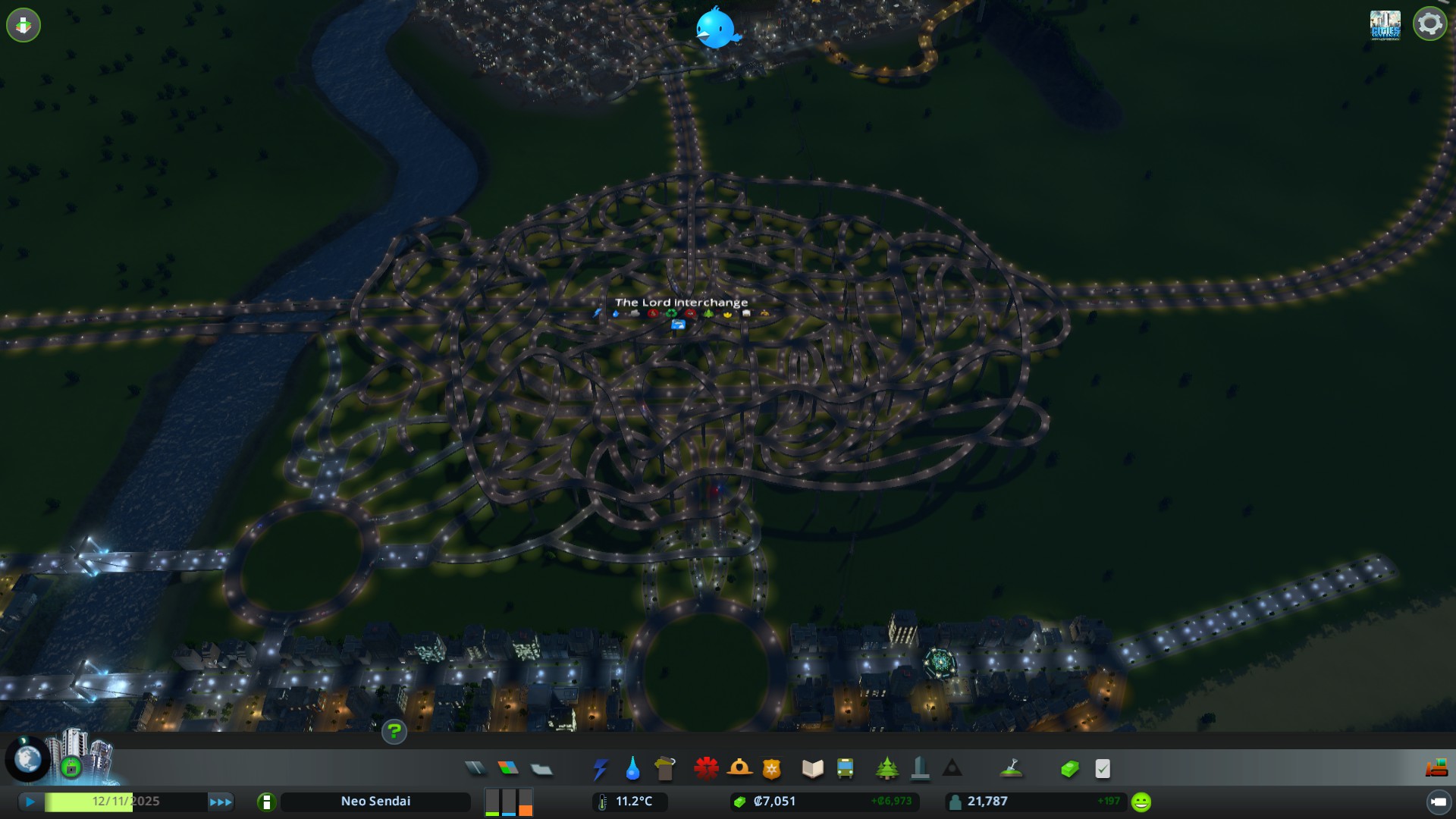Species An image of a Tougpasa in the antisol territories of the Great Republic, circa 40 YBU. Of special note are her small ears compared to other Tougpasa, an adaptation to the cold climate of the antisol lands.
An image of a Tougpasa in the antisol territories of the Great Republic, circa 40 YBU. Of special note are her small ears compared to other Tougpasa, an adaptation to the cold climate of the antisol lands.The Tougpasa are a humanoid species, generally of slightly shorter stature than humanity due to the high gravity of their homeworld of Wusdafu. It is tidally locked to its sun, a red dwarf star dubbed Shav'nefo (which unsurprisingly translates to "sun"), and as a result only has a thin strip of land that would be human-habitable. At it's Solward and Antisol poles it is completely uninhabitable, and winds constantly blow from one side of the world to the other. The Shav'nefo system itself is approximately 20 light years from Sol.
Ironically, the hells on either side of the world give way to a near paradise at the Solar equator in the middle. A lush rainforest covers the landscape, with most plants having massive leaves to soak up as much of the rare sunlight as possible. The constant, planetary-scale hurricane caused by the nature of the planet gives rise to an almost constant rain within the so-called twilight rainforest. The impact of this environment upon Tougpasa evolution is obvious.
First of all, it is seen in their most prominent feature that sets them apart from other humanoids. The Tougpasa have large, pointed, furry, cat-like ears on the top of their head. They have impressive control over said ears, with countless muscles being dedicated to rotating and turning them to track a sound. Furthermore, their ears have the most nerve endings out of any place on their bodies. This gives them an uncanny ability to hear in their generally rather soundproof native habitat. They also function as heat radiators for Solward inhabitants (the Tougpasa developed better heat dissipation techniques since the Antisol side of the planet is devoid of conventional plant life, and thus only very sparsely populated). It is worth noting that there is a Tougpasa race with smaller, furrier ears that originated on the Antisol side of the planet. The large ears of the majority of the Tougpasa, after all, would have been a liability in an environment which demands maximum heat retention.
Second is their eyesight, which has evolved similar to that of a Terran cat's. Their eyes contain a tapetum lucidum-a reflective layer that allows them to see easily at night and in dark areas, with the side effect of making their eyes seem to glow in the dark. This is an adaptation to the heavily wooded rainforests of Wusdafu, as most trees have gigantic leaves in order to soak up as much sunlight as possible, making the ground extremely dark closer to the Antisol side (since less sunlight can reach it). This combined with their hearing has made the Tougpasa excellent hunters, and later on excellent warriors. Also complementing their fighting ability are tails, which allow them to better maintain balance and prevent falling (which is dangerous in Wusdafu's high gravity).
The most obvious difference between the Tougpasa and most other species is that they do not sleep. Having evolved on a planet without day or night, only constant twilight, the species of Wusdafu did not need to go inactive in the dangerous night. As a result of this slack of sleep the Tougpasa have an incredible memory, as their brains must process and memorize information without a period of inactivity. An entire extra lobe of the Tougpasa brain is dedicated to, more or less, daydreaming that allows them to commit things to memory while awake with the same effectiveness (and perhaps more) as humans do while sleeping. These "daydreams" are closer to the dreams humans have but don't remember during sleep, rather than a human daydream, as the individual isn't aware of them at any point.
Within their body, they have a variety of different adaptations to their homeworld that aren't immediately noticeable. First of all are their bones, which are notably larger than those of a human due to the high gravity of Wusdafu. Their muscles, too, are of a higher density but not physically larger (which tends to make the Tougpasa seem to be impossibly strong on lower gravity planets). Their lungs are also larger than their human counterparts, as is their heart, in order to allow their bodies to more effectively circulate air and blood in high gravity.
Finally, Tougpasa reproduction is somewhat strange compared to human reproduction. An only child for a Touspasa is almost unheard of, and the gestation period is almost half that of a human. The tradeoffs, however, are obvious. A pregnant female flat out cannot fend for themselves, and as hunter-gatherers the Tougpasa would stop in the same general area for the entirety of mating season (and then some) to ensure that all children would be born healthy. The body of a Tougpasa female will always favor itself over her child during gestation, and a shortage of nutrients would harm the growth of the baby in favor of keeping the mother alive. As a result, miscarriages were extremely common. To combat this, the Tougpasa actually have two separate mating seasons every (long) year. If there is a famine in one, then the second may have better conditions.
Description of governmentThe PUW's government is split into two distinct parts in order to ensure functionality and liberty. One part is the so-called Military Sector, which is governed by a council of military leaders and elected (military) industry representatives in tandem with a single individual hand-picked by both the council and the last person to hold the position. The Military Sector handles, as the name implies, all military activities. Beyond that, however, it manages military industry (with a stricter hand than the Civilian Sector handles civilian industry) as well as diplomatic relations. As such, it was considered the "true government" by most other powers on Wusdafu before unification.
However, to the citizens of the PUW, the Civilian Sector is the true government. It handles the bulk of the work a single government would, seeing to both domestic policy and all industry not directly connected to the military. Using the Union's (notably primitive in design for its capabilities) computer network, all civilians are able to vote directly on issues in their local area. All Union territory is broken up into regional areas, generally based on former state and ethnic borders. Each region has laws set by direct vote from the citizens, and any citizen can propose a new law (which would then be reviewed by a small team of regional "Directors" to ensure it is both realistic and incapable of undermining the Union's core values. Each individual workplace can organize itself as it sees fit, but is given a strict monthly production quota based upon the needs of the Union as a whole. These quotas are set by a series of supercomputers, all connected to each other and a central computer that calculates the necessary resource requirements of the entire Union and doles them out to the most fit regions. This system of supercomputers, dubbed the Cybernetic Gestalt, is the closest thing to a governing body the Civilian Sector has beyond its own people.
Description of militaryThe Union military is split up into three separate main forces: the Army, the Air Force, and the Space Force. Wusdafu's lack of any large bodies of water beyond a few lakes has prevented a true Navy from being organized at any point in history, and vessels that patrol rivers and lakes are organized under the Army.
The Union Army had the distinction of being the first military force to be created by the Union during the Sillan Revolution in 100 YBU. Beginning as a simple guerilla force, the Union Army became the victors of the Twilight War (85-0 YBU). Since then, it has acted as the fist of the Union's people in wars across the entire Shav'nefo system.
It is organized in numerous different units, all of which are uniform in number. With the exception of a fireteam (five men) and a section (25 men), all Union units are sized in multiples of ten. After fireteam comes a squad of two fireteams (ten men), a section of two squads plus five specialists (25 men), a platoon of two sections (50 men), a company of two platoons (100 men), a cohort of five companies (500 men), a battalion of two cohorts (1,000 men), a brigade of five battalions (5,000 men), a division of two brigades (10,000 men), a corps of five divisions (50,000 men).
A corps is generally the standard deployment of the Union Army, and was the standard response of the Union to any small nation that was deemed either a threat or an opportunity. In larger scale, symmetrical wars, corps are organized into fronts that can be anywhere from two to ten corps large.

The workhorse of the Union's infantry is the Type 33 Modular Pattern Infantry Rifle (DMAS-33). As the name implies, it is a modular rifle designed to be capable of being modified for use in any environment or situation on the fly. It features full auto, semi auto, and burst fire modes and accepts both a short magazine (as pictured) a longer, curved magazine, and even a drum magazine. Between missions, it is possible to extend the barrel, easily attach or detach a scope, modify the stock (for rural vs. urban combat purposes), and even switch out the receiver entirely to allow for a more or less powerful bullet to be used. It is, essentially, various different rifles that all go by the same name. A rarely used bullpup version also exists.

The Union's Type 51 Anti-Material Phased Plasma Rail Rifle (UDMMSS-51) is a type of weapon first deployed in the Second Unification War (31-23 YBU), an anti-material rifle designed to be used against power armor. Unlike previous electromagnetic rail rifle designs (which were designed to pierce armored vehicles), the UDMMS-51 was designed to have semi-automatic fire capacity and an almost nonexistent charge time. It fires shells filled with an argon/hydrogen/nitrogen gas mixture that is ionized into plasma when fired. Upon impact, the plasma and the shell punch through the targeted power armor and into the person inside. A higher powered version (the UDMMSS-51-A) exists, and is used against vehicles that are better protected than power armor suits.

The pride and joy of the Army's infantry is the Type 49 Armored Mobility Enhancement Suit (UDOL-49). It is truly a behemoth, being a massive hulk of metal armor designed to protect the wearer from small arms fire, shrapnel, and even some explosives. Many parts of its design are simply for intimidation, as the "eyes" are not actually in the same location as the pilot's eyes. The head, and entire suit itself, is significantly larger so as to allow the pilot's head and hears to fit within the helmet without restricting movement (thus why there are not earholes as seen in normal helmets). The UDOL-49 uses a special modification of the UDMMSS-51 (the UDMMSS-51-B) that is capable of semi-auto, full-auto, and burst fire along with more or less just being an upscaled version of the original weapon. UDOL suits are as a result often deployed against enemy armored vehicles, as the UDMMSS-51-B is more than capable of piercing even the armor of a main battle tank.
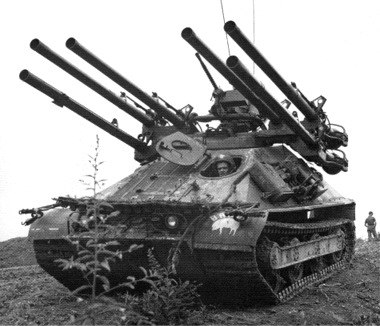
As the lightest of the Union's armored vehicles, the DKRGB-21 (Type 21 Multi-Shot Light Tank Destroyer) is one of the fastest vehicles at the Union's disposal. Though it won't block anything more than light small arms fire, it's six coilguns can pack a heavy punch against an enemy tank. Ironically, they are also extremely effective against infantry forces, as their coilguns can easily pierce most walls and their quick-firing nature allows any building full of enemy troops to be peppered with HE shells. As a result, the DKRGB-21 is still deployed in battle against infantry forces despite the extreme age of the design.

The FMDKG-55 (Type 55 Nuclear Powered Main Battle Tank) is the workhorse of the Union's armored forces. Powered by a nuclear reactor, the gigantic tank rarely requires refueling and produces a truly massive amount of power for its weapons systems. The excess is used to power its twin defensive systems: the Shockwave Dissipation System (KBL) and the Plasma Arc Projector (MUM). The former creates a shell of ionized air around the tank to dissipate shockwaves from nearby explosions before they reach the tank itself, and the latter creates arcs of high-energy plasma across the hull of the tank to zap incoming shrapnel and projectiles out of the air. The main gun is a high-velocity railgun that, in some cases, can be used as light artillery against faraway troop formations. Secondary weapons include two automatic coilgun turrets and a top-mounted UDMMSS-51-B turret.
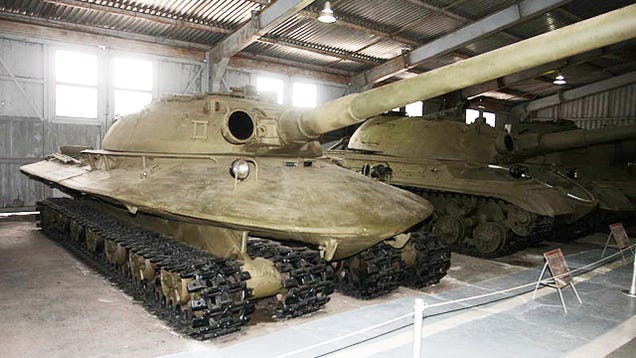
The Gisgro Tank is named after a snail-like animal native to Wusdafu that forms an extremely thick protective shell that was highly sought after in ancient times due to its total immunity to arrows. The Gisgro Tank has good reason to be named after such a creature. It is a slow, lumbering beast that is designed for the sole purpose of surviving a strategic nuclear attack. It's sloped armor allows it to survive just about anything short of an artillery strike, and even then said strike must be capable of penetrating it's heavy armor. It's main weapon is a significantly downsized (for space reasons) version of the railgun used on the FMDKG-55, and as a result has reduced effectiveness against most heavier vehicles. It also lacks anti-infantry capabilities. The only way for any force to defeat the Gisgro without calling in some form of vertical strike is to either take out its treads (best done with mines or a well-placed rocket shot) or use a directed energy weapon which ignores the sloping of its armor entirely. The Gisgro exists, however, not to dominate the battlefield but to act as the last arm of the Union were it to be obliterated in a nuclear attack. It is rarely deployed due to its expense, but some of the more unconventional generals like to make heavy use of it.

The Kurralagu SPG is a self-propelled artillery piece designed to be used to attack enemy troop formations, encampments, and command posts from well out of range. It's a simple vehicle: very big engine, very big railgun. It is notably capable of firing two specialized shells, a heavy armor-piercing shell that can pierce the armor of an Air Force destroyer and a cluster munition shell that can devastate a large clump of troops with ease.
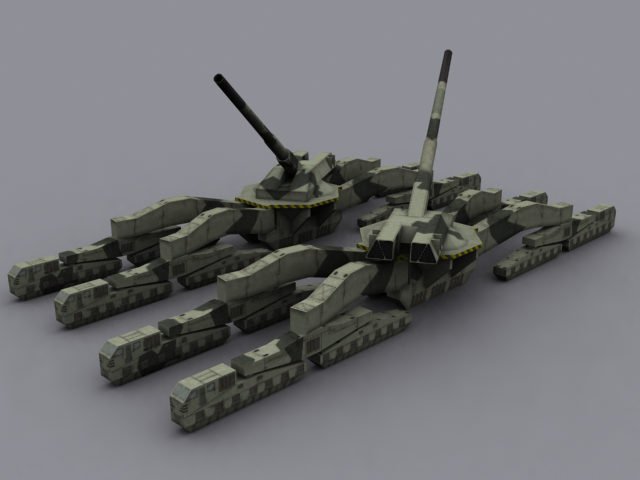
Finally, there is the Konodej Strategic Railgun. This truly massive "vehicle" is only kept moving through the usage of negative mass ballast which prevents it from sinking into unstable ground. It is the slowest vehicle built by the Union, and as a result is transported by rail whenever possible. Once it has set up to fire, however, it is the most powerful weapon on the battlefield. It fires the same shells used in the cannons of Air Force battleships, and generally carries nuclear shells. Since it cannot track anything that moves faster than a slug, it is used exclusively as a siege weapon. In some cases, it is even deployed in lieu of a strategic bombing run.
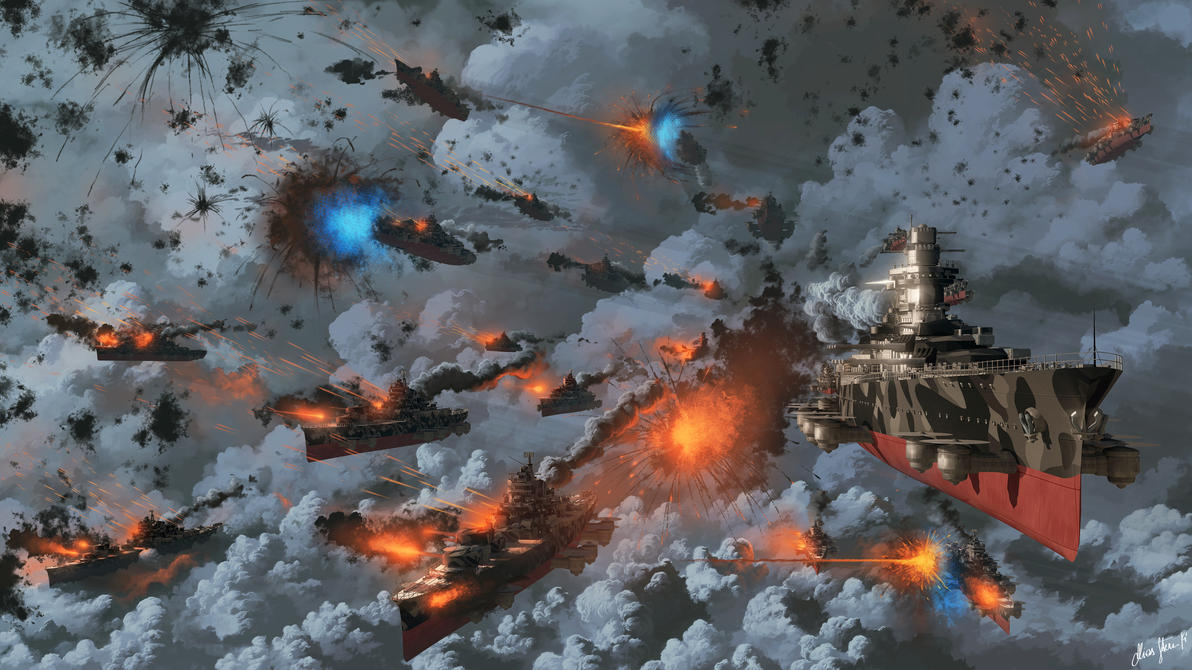
The Air Force of the Union is the descendant of air forces that have fought in the skies of Wusdafu since the invention of the sail. Kept aloft by negative mass ballast, Union airships do battle in much the same way as warships did on earth during the Second World War. Big guns and lots of armor are the Union doctrine. Technological advancements have led to massive upgrades being doled out to the Union Air Force, the two most important of which are the railgun and plasma arc system. Railguns have allowed vessels to engage in traditional artillery battles at missile range, which greatly increases the effectiveness of battleship classes against modern destroyers. Plasma arc systems like those seen on the FMDKG-55 provide Union airships with protection previously unimaginable, stopping no trivial percentage of even the largest shells from hitting their target.
In modern times, the Union Air Force functions as a planetary guard. Were a Union world to be invaded, enemy spacecraft would be forced to contend with warships specifically designed with the purpose of atmospheric combat against heavily armored opponents. They also commonly serve to support ground troops in assaults, lending their heavy artillery (and sometimes nuclear shells) to suppress and kill enemy forces.
Finally, the pride of the entire Union, the Space Force.

The O'upro fighter craft has an unconventional appearance compared to other Union spacecraft. As a small parasite vessel, it wasn't built in orbital docks like the majority of Union ships and as a result its designers chose to give an almost artistic quality to it. In creating it, the design team made every effort to make it as beautiful as it is effective. Its four wings each carry a coilgun that uses depleted uranium rounds, similar to those used by ground attack aircraft by the air force. In addition, each wing also has a point at which a conventional missile can be mounted. The nosecone of the craft (which provides extra armor for the otherwise exposed cockpit) can also be removed to mount a heavy torch missile for the purpose of hitting capital ships. The O'upro, though an odd design, has won the hearts of many a Union pilot.
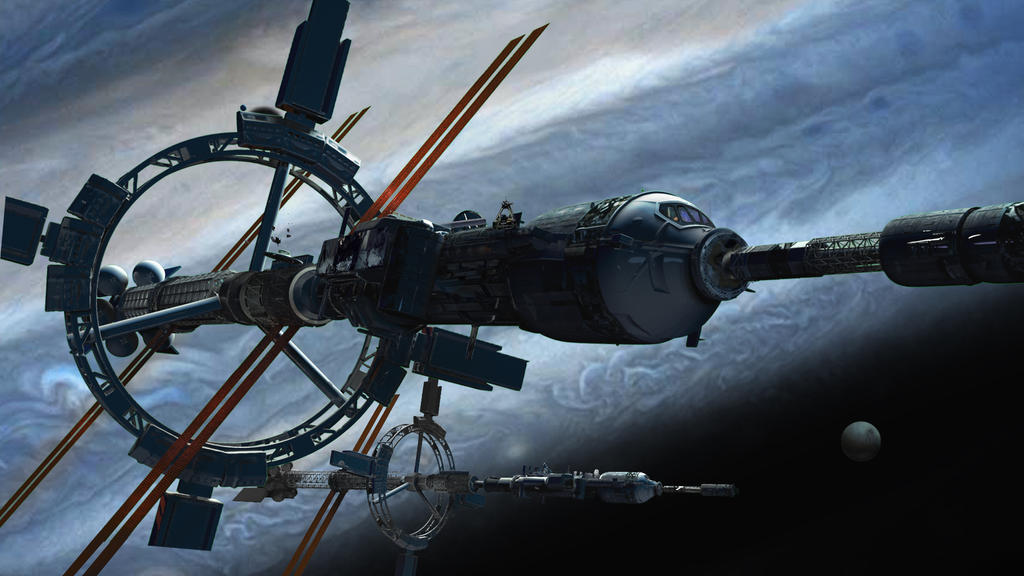
Next in line is the Dwerfas-Class Kinetistar, a fragile vessel (as evidence by a large part of it literally being trusses), but in no way a pushover ship. It is the embodiment of the glass cannon, and carries the single largest railgun manufactured by the Union. It's fragile design, only slightly remedied by its plasma arc system, makes for a fast ship that can easily reposition itself on the outskirts of battle to fire inwards with one of the most powerful weapons used by the Union. Aside from simple kinetic kill vehicles, its main gun can also load nuclear shells in order to tear apart even the largest capital ships if they aren't careful.
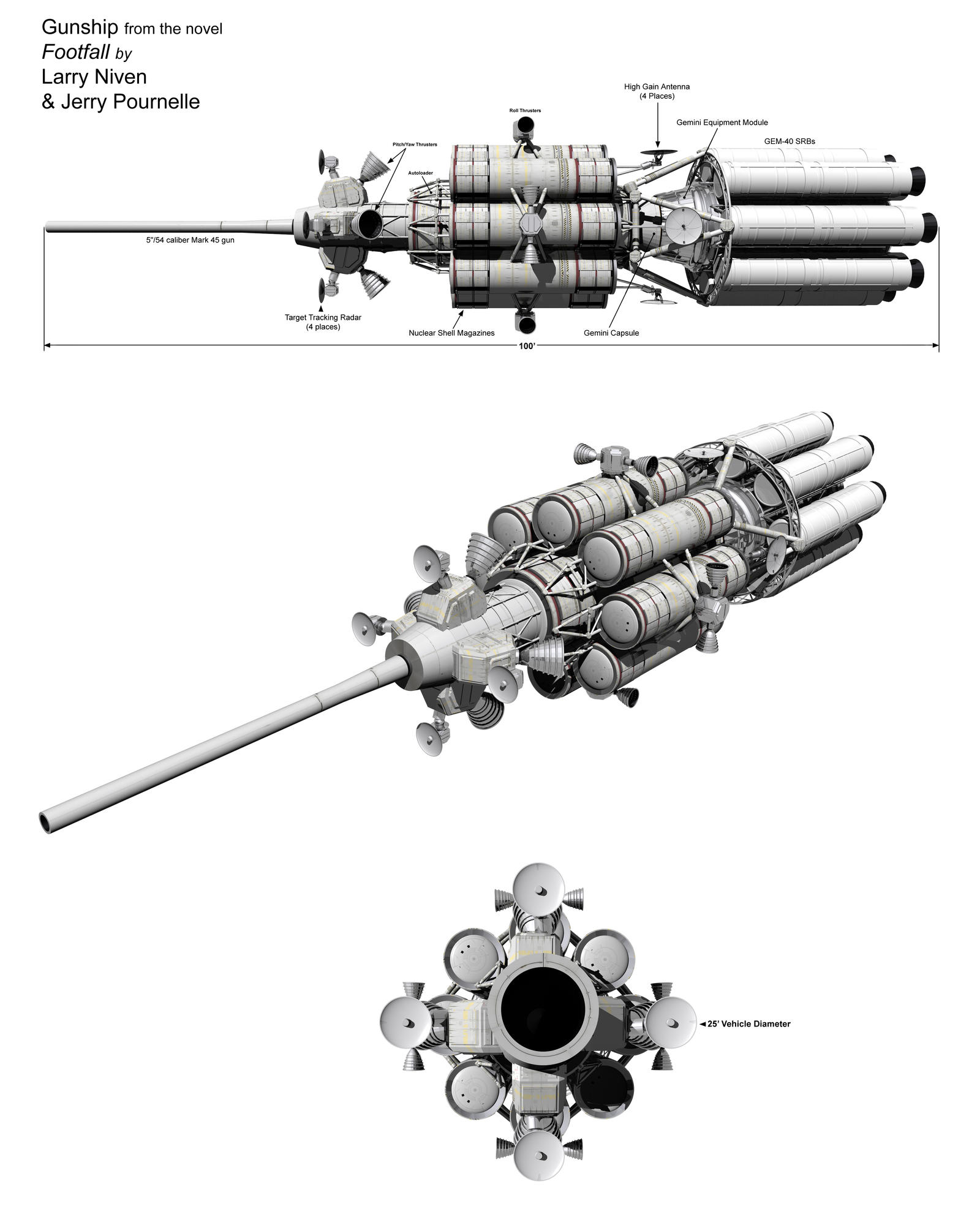
The Tfapng-class Lancer is an oddity. It, like the Dwerfas, is fairly fragile (though it has a significantly better plasma arc system), but it delivers its payload in a much less conventional way. It accelerates directly towards the enemy, fires its nuclear tipped shells, and then turns around for another pass. Approximately half of each shell's velocity comes from the vessel's speed itself, giving it the designation of Lancer.
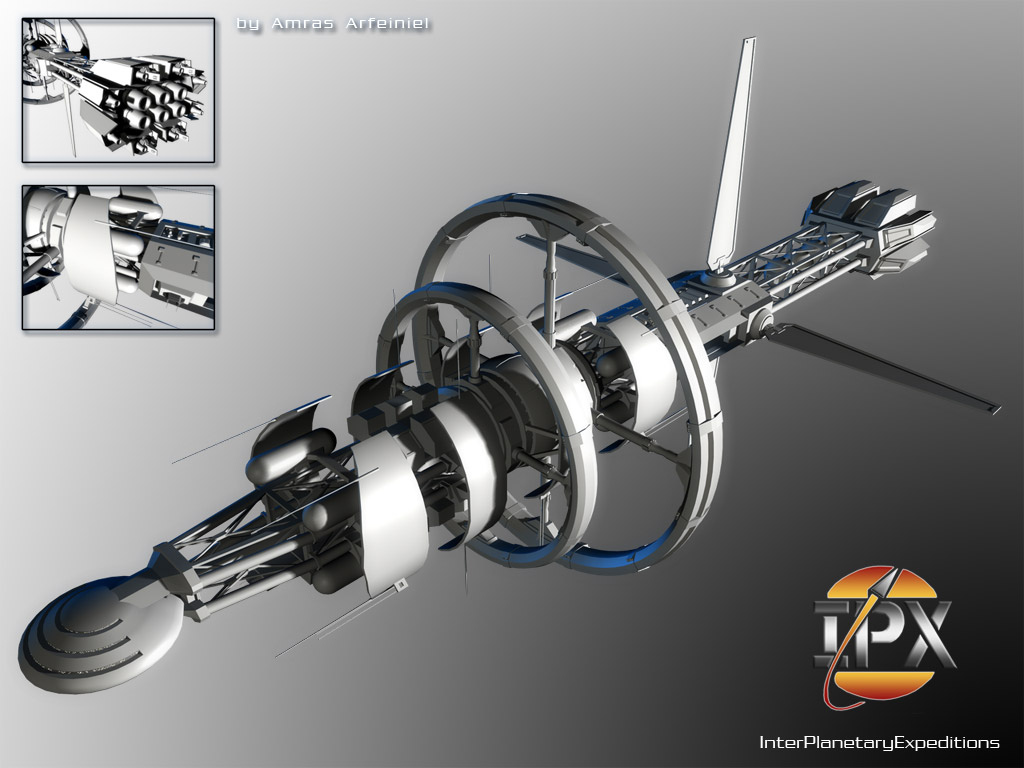
The Glus-class Mothership is yet another primary damage dealer of the Space Force, but is also it's greatest defense. It carries a great number of kirklin mines (pictured below), the primary purpose of which is to intercept incoming missiles by ramming them. Their secondary purpose, however, is to ram enemy spacecraft using numerous explosive payloads attached to poles. Though a line mine won't do much damage to another vessel at all, a swarm can be fairly effective. In addition, it is the carrier of "torch missiles": gigantic missiles (with only four or so being loaded on any Glus-class) that ram enemy ships at near-relativistic speeds and detonate a nuclear payload. They are designed to be able to chase an enemy vessel between multiple planetary orbits, meaning that the only way to truly be safe from one is to shoot it down or outrun it across the entire system. As a result of their extreme expense, these missiles are only deployed against the most formidable of enemy ships.
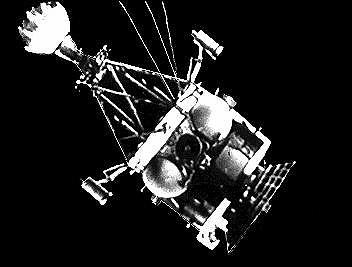
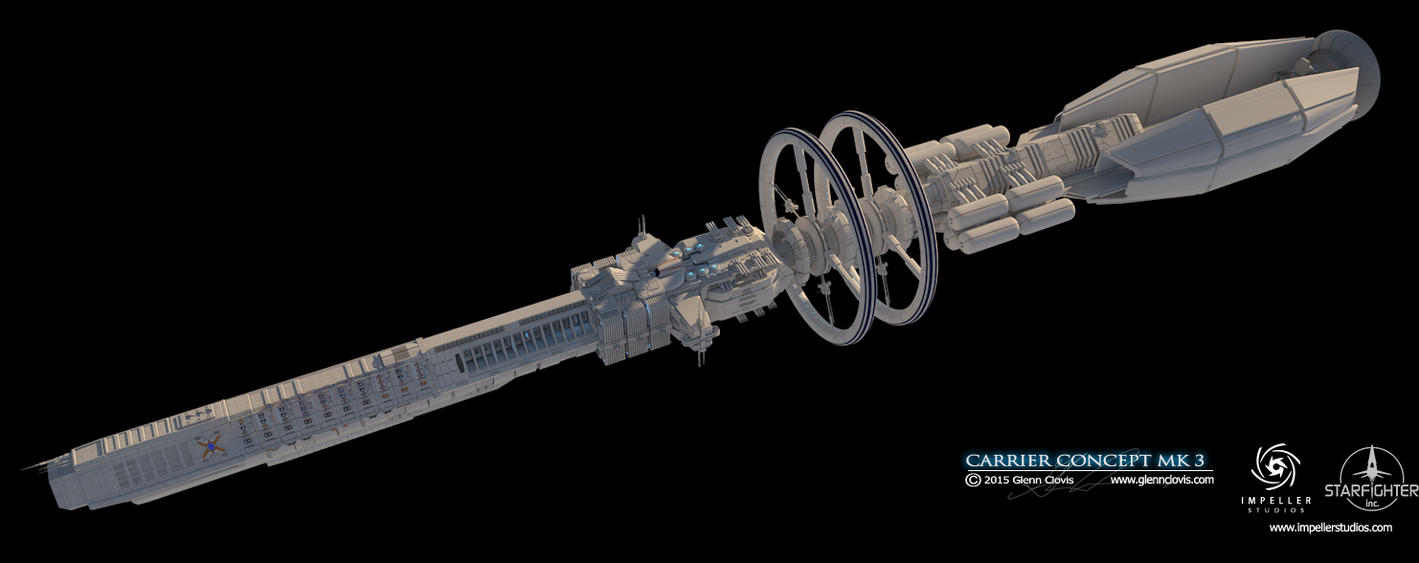
Finally, there is the Presch-class Parasite Carrier. This ship is the largest, most heavily armored vessel in the entirety of the Space Force. It carries countless O'upro parasite fighters into battle, and even packs a punch all of its own with twelve Air Force railgun turrets. This class is the true backbone of the Union space fleet, being more of a Battlestar than a simple carrier. Dispatching one to planetary orbit is a clear sign of the Union's dedication to any given issue, and with it's impressive armament of its own it can truly wreak havoc on a strategic scale. It is, at its core, a vessel that can do whatever is asked of it. The designers provided it with a sturdy enough structure and enough negative mass ballast that it can enter a planetary atmosphere and do battle with aerial forces within. Were the Union to undertake an interstellar expedition to uncharted territory, this would be the first ship to make landfall.
Technological Overview
The Tougpasa are, in comparison to most other spacefaring species, rather primitive. Their technological development was strange from the beginning, as their homeworld of Wusdafu has streams of negative mass flowing underground. Though it is unknown if these streams somehow occurred naturally, or are the result of previous inhabitation by an advanced species, their presence caused the Tougpasa to develop along an unexpected path. Indeed, artifacts from ancient times show that tribal hunters would wear backpacks filled with the liquid negative mass to allow them to leap through the trees of the rainforest to catch their prey.
As a result, the Tougpasa make widespread usage of negative mass in their technology. Since the invention of the sail they have launched airships kept aloft by it, and today they use it to lift massive aerial battleships as well as spacecraft. It has also found domestic uses (such as in most Union cars) as well as more military uses in the creation of antigravity harnesses for soldiers based upon those same ancient "lifting packs".
Aside from the fairly advanced nature of their negative mass-based technology, the Tougpasa are behind the times in most other areas. This is easily visible in their spacecraft, which contain obvious large habitation wheels, general structures reminiscent of early human spacecraft, and often nuclear pulse drives. Their infantry still make heavy use of firearms, and only anti-material weapons (or the newest heavy anti-infantry ones) use electromagnetism. They have no passive shielding technology whatsoever, relying on active defenses such as the Shockwave Dissipation System and Plasma Arc Projectors to prevent damage.
The field in with the Tougpasa is least advanced (or perhaps the field which evolved the strangest, depending on who you ask) is electronics. Most households have computers on par with those seen in the human 1990's, but they are not self-contained units. Instead, they are simply terminals connected to a central computer in the regional capital that is housed in a gigantic skyscraper. This is largely because Tougpasa computer development halted in 20 YBU, with all available resources being poured towards the war effort. As a result, the Union equivalent of a personal computer is a hot, whirring mess of cables the size of an entire city apartment. The vast majority of citizens understandably choose to just use a terminal connection, but some eccentrics still use self-contained units.
For power generation, the Union uses exclusively fission reactors. They have mastered and miniaturized this technology, to the point that it is used in everything from starships to cars. Fusion, on the other hand, is still very much out of reach. Union scientists and engineers have yet to produce a practical fusion reactor, though a few experimental designs are in development.
Cultural OverviewTougpasa culture is heavily influenced by the environment of their homeworld, with them adopting a philosophy based upon the scorching heat and freezing cold of the Solward and Antisolar poles respectively. The fusion of two opposites-dark and light, cold and heat-creates a synthesis: the Twilight zone of the planet. This basic view is applies to countless things throughout Tougpasa culture, including history. The general idea is that a flawed state (cold and dark) is fused with a less flawed state (light and heat) to create a favorable synthesis. It is a simple idea: thesis, plus antithesis, equals synthesis.
This lends itself well to cooperation. Two opposing strategies can more often than not be fused together to create a significantly better synthesis strategy, and as a result much of Tougpasa decision making rests on what could be considered compromises. This often leads Tougpasa strategists to propose strange and unorthodox strategies, as they take two other propositions and create a third one to deal with the flaws of each.
Tougpasa religion is more or less a collection of tales involving the Latch Mo'emro, or Sky People. They were supposedly earless, humanoid beings that visited the Tougpasa in ancient times. According to the texts, they gave the Tougpasa various magical gifts. Great bows that could pierce walls, chariots propelled forward on the ground, water, and sky by magic, and countless other gifts. They laid out a series of ten laws, all of which the Tougpasa are said to have followed dutifully.
However, the Latch Mo'emro were engaged in a heavenly war with the Latch Bodefl (or Sky Demons). There are many stories of Latch Mo'emro heroes, and even Tougpasa warriors fighting the Latch Bodefl. In the end, however, it is said that the heavenly war reached Wusdafu. The dead bodies of Latch Mo'emro and Latch Bodefl alike rained down upon the world for a full year, their blood seeping into the ground and poisoning the water. With the defeat of the Latch Mo'emro, their magical gifts ceased to function and disappeared forever.
The texts say, however, that one day the Latch Mo'emro will return and the Tougpasa will once again be called upon to fight the Latch Bodefl by their side.
HistoryTougpasa history begins in the rainforests of Wusdafu, where they lived as hunter gatherers. The first evidence of Tougpasa society and technology can be found in the massive trees of the rainforest, some of which were hollowed out by early Tougpasa to be used as dwellings. Primitive tools can also be found, which give insight as to how these societies lived. Long, hooked poles were used to pick the abundant fruits of the same trees. Interestingly, this also seems to be the first example of Tougpasa agriculture, as large leather sacks suggest that they actively watered the same trees during droughts.
Later on, there is evidence of early inhabitation of the savanna area closer to the sun. At around the same time, the Tougpasa began to actively plant and raise domesticated plants. In the rainforest, they would chop off the leaves of the larger trees to plant ones of the same species for their fruit, but intentionally keep them small so as to manage them easier. In the savanna, Tougpasa settlers domesticated various grasses in the area. One of which closely resembles the various species of Terran rice, and in modern times has become a staple of the Tougpasa diet.
The savanna was the first place in which the Tougpasa constructed buildings themselves, and an ancient civilization arose along one of the major rivers in the region. At some point, for unknown reasons, its influence exploded across Wusdafu. Coinage from it has been found at both the Solward and Antisolar poles of the planet, which suggests that they were significantly milder at some point in Wusdafu's history. Ruins from that civilization, dubbed the Shaslag Efol (first ones) can be found all across the planet. The few remaining cities show clearly that they were highly advanced for their time, with roads being laid out in grids, made wide enough for carts, and being built mostly only on sturdy ground. Older ruins have clear palaces and such, but after the massive population boom such things vanished entirely.
At some point during the reign of the Shaslag Efol, however, a catastrophe befell Wusdafu. A truly massive hail of asteroids (speculated to have been made up of upwards of a thousand individual objects) slammed into the planet at almost exactly the same time. A resulting cloud of dust stamped out countless farms, wiping the Shaslag Efol out entirely and knocking the Tougpasa back into being hunter-gatherers. The usage of negative mass in its first purpose (greater mobility when hunting) appears around this time, which suggests that the asteroids seeded the planet with negative mass.
Artifacts recovered from the time period include the first spears, which were held as one would hold a rifle and used to repel charges or stab prey in a jumping attack. The appearance of animal domestication (re-domestication, that is) would eventually cause such weapons to be replaced with larger spears, as a spear held like a rifle against the shoulder has little ability to absorb the shock of a mounted soldier.
The population numbers of the Tougpasa gradually recovered, and another civilization rose up in the rainforest in tandem with one in the savanna. These two civilizations formed the Tougpasa equivalent of Earth's classical era, with plenty of interaction across trade lanes spanning the planet's habitable zone. Sadly enough, both civilizations met
their fall in a second catastrophic meteor shower, just like the first one. This time, however, it was less of a near-extinction and more of a massive societal disruption. Both civilizations broke up into various different warring states, which is the beginning of well-recorded history.
In the rainforest, one of these small states, the Kingdom of Ksagu'af developed the lateen sail. This innovation soon led to the creation of the first controllable airship on Wusdafu, which was initially used as a reconnaissance vessel for the Kingdom's armies. Around the same time, small states in the savanna invented gunpowder. Eventually, the two innovations were combined to create the first true aerial battleship.
The challenges posed by the savanna has long made the savanna nations less prosperous than those in the rainforest, but that all changed when the Lepf Empire unified the majority of the savanna territories under its rule. With a highly centralized government, the Lepf Empire put a great deal of emphasis on increasing the prosperity of its relatively barren territory. This led to new irrigation methods, wind and water mills becoming widespread, and finally among the greatest events in Tougpasa history.
The industrial revolution.
The usage of coal to power machinery came about in 274 YBU in the Lepf Empire, and caused a population explosion previously unseen since the times of the Shaslag Efol. This technology eventually reached the rainforest, and soon afterwards the entire (habitable) planet was more or less on par technologically. This presented a unique problem, as on Earth natural barriers caused some civilizations to be highly advanced while others were still in the stone age. On Wusdafu, all civilizations advanced at more or less the same rate.
As humanity saw in Europe, there is only one outcome to having multiple different industrialized nations all vying for territory.
The Great War began. All of Wusdafu erupted into a chaotic war, with three massive alliances pitted against each other in an effort to expand their own influence. Every side, however, was provided weapons and supplies by the same corporations. Those corporations, owned largely by families that had once been feudal lords, fit the human mold of an Illuminati quite well. Union historians, in fact, have uncovered that it was those families that actively lobbied for the entry of countless nations into the Great War. Not to make money, but to keep their positions safe.
Before the war, unrest was rising across the world. With the feudal lords of old now in charge of the industries that, in humanity's history, became controlled by merchants, the peasants had begun to seriously oppose their rulers. The ideology of Levellerism-an evolved, communistic form of the obscure ideals that on Earth began the enlightenment-exploded throughout the world. The best way to combat unrest, of course, is to give those in unrest a bigger problem. The elites of Tougpasa society did this by starting a war that killed thirty million, all to harness that "rally around the flag effect".
In the end, it failed miserably as the savanna nation of Silla fell to Levellerist revolutionaries in 100 YBU. The revolutionary government absorbed the former vassals of Silla, and in 93 YBU it supported a string of revolutions in other nearby savanna countries that were soon absorbed into the new, levellerist Union. In 85 YBU, the ancien regimes of Wusdafu formed an alliance and collectively declared war on the Union. They had expected the war to be a quick, easy assault. As is obvious by the fact that it ended 85 years later, they were wrong.
The first assault was met with fierce resistance and turned back by Union forces, which had been well prepared for such a war. In fact, the Union government is now known to have been planning their own attack. Those plans, unsurprisingly, were used as the basis to a massive counterattack in the early days of 84 YBU. This elastic back and forth in the early years of the war was common, until things had solidified into a single, contiguous front spanning the entire solward border of the twilight (occuring in roughly 82 YBU). The Union, as of then, had secured various major victories that had brought the savanna under their control.
In contrast to Earth's first world war (which was similar in that it had giant fronts, with each side focusing heavily on defense), the "Twilight War" as it would be called went on for decades. This, of course, was the result of the Tougpasa's ability to reproduce quickly. Even though millions fell on the frontlines, millions could be called up from both sides to replace them. Years turned into decades as the war raged on, with a yearly armistice for one of the mating seasons not helping bring an end to it all at all.
Though all of society had been changed from the presence of a seemingly eternal war, it didn't stop it from evolving in different directions. In Union territories all thoughts were focused on defeating the enemy to secure freedom to all Tougpasa, and all technology developed to do so. Computers came about as codebreakers, rockets came about as missiles, and every building was designed to withstand bombardment and act as a possible fortress were the enemy to reach a Union city.
In the opposing lands, however, things took a very different turn as they had to fight an enemy both without and within. Rising popularity of levellerism meant that the Alliance had to keep its own populace in control. They did so by focusing a good portion of their resources on entertainment, to keep their people preoccupied. And when they weren't preoccupied, they would be enraged at the Union. In the later stages of the war (20-0 YBU) the Alliance had to focus all effort on the war, becoming what could best be described as a fascist, cyberpunk hellhole by human terms.
The war finally came to a close in 0 YBU, with the combination of a massive civilian uprising and a truly colossal Union push doing the Alliance in for good. The current date is 60 YAU (years after unification), and the Union is more prosperous than ever before. The ancient jump gate found in orbit of Wusdafu's moon has connected them with the closest nearby system, allowing them to begin their expansion before even inventing FTL.
The invention of the negative mass space manipulation drive, which works on the same principle as the human warp drive, the Union is finally ready to venture into the furthest reaches of deep space. And in doing so, further the will of its the people.
